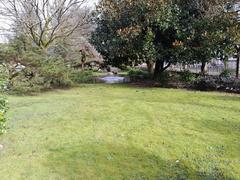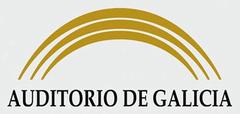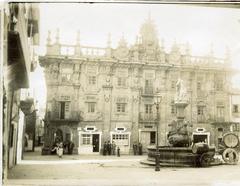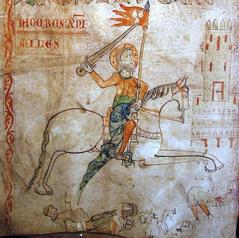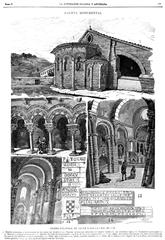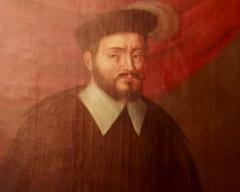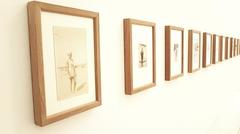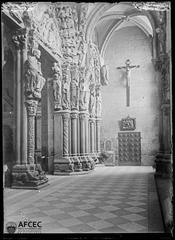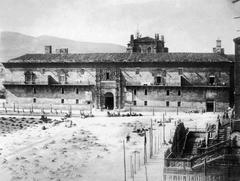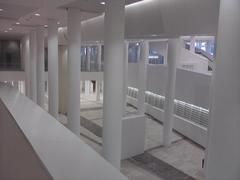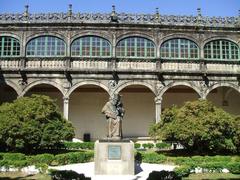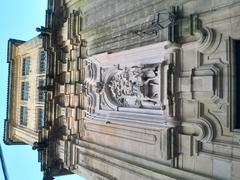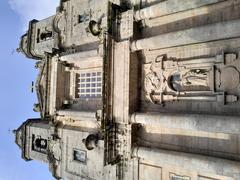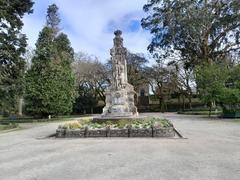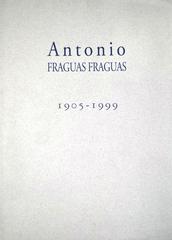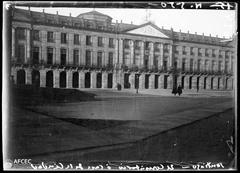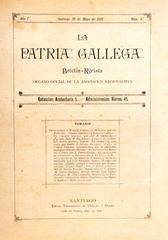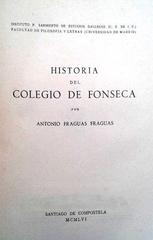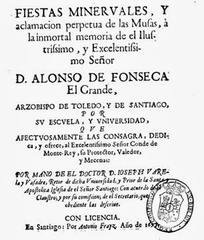Casa da Conga Santiago de Compostela: Visiting Hours, Tickets, and Historical Sites Guide
Date: 04/07/2025
Introduction
Casa da Conga is one of Santiago de Compostela’s most iconic Baroque civil buildings, standing at the southern edge of the Plaza de la Quintana, in the heart of the city’s UNESCO World Heritage-listed historic center (UNESCO; Paxinas Galegas). Originally constructed in the early 18th century to house the canons of the Cathedral of Santiago, Casa da Conga reflects both the ecclesiastical and civic ambitions of its era. Today, it is celebrated for its harmonious Baroque architecture, rich historical significance, and vibrant role within the urban and cultural life of Santiago.
This guide provides a detailed overview of Casa da Conga’s origins, architectural highlights, historical transformations, and up-to-date visitor information, including hours, ticketing, accessibility, and travel tips. Whether you are a pilgrim, architecture enthusiast, or traveler, this resource will help you make the most of your visit to one of Santiago’s most remarkable landmarks (Santiago Turismo; Spain.info).
Table of Contents
- Introduction
- Historical Background: Origins and Construction
- Architectural Features and Urban Context
- Historical Functions and Transformations
- Visiting Casa da Conga: Practical Information
- Cultural Significance and Symbolism
- Frequently Asked Questions (FAQ)
- Summary and Recommendations
- References
Historical Background: Origins and Construction
Casa da Conga was commissioned in 1709 by the Cathedral Chapter to serve as the residence for the canons (“conga” being derived from “canónigos”). The original design was by Domingo de Andrade, a celebrated architect of the Galician Baroque, and the project was completed in 1730 by Casas y Novoa, renowned for his work on the Obradoiro façade of the cathedral (Paxinas Galegas; Wikipedia GL). The building consists of four houses unified by a continuous granite portico, creating a dignified yet welcoming façade that anchors the southern side of the Plaza de la Quintana.
Architectural Features and Urban Context
Casa da Conga exemplifies Galician Baroque civil architecture, with its robust granite construction, symmetrical façade, and restrained decorative elements. The ground floor is defined by a handsome portico supported by Doric columns and semicircular arches, providing shelter and encouraging social interaction. The upper stories feature regularly spaced windows and wrought-iron balconies, all unified by classicist proportions and understated elegance (Santiago Turismo).
The building’s location is integral to its significance. It frames the southern edge of the Plaza de la Quintana, historically known as the “praza do mortos” due to its origins as a cemetery, and forms a visual and functional link between the cathedral, the Monastery of San Paio de Antealtares, and the urban fabric of the old town (Coworking Santiago).
Historical Functions and Transformations
Ecclesiastical and Academic Uses
Initially, Casa da Conga housed the canons responsible for the liturgical and administrative life of the cathedral, reflecting its close ties to both ecclesiastical and academic institutions. Its construction coincided with the development of other important buildings, such as Casa da Parra and the relocation of the San Xerome college portal, symbolizing the continuity and prestige of Santiago’s religious and scholarly communities (Cervantes Virtual).
Modern Adaptations
In the 21st century, Casa da Conga underwent thoughtful restoration to integrate modern amenities while preserving its Baroque character. Today, it hosts a range of cultural and institutional functions, including the Campus Stellae Business and Coworking Centre, the Colegio Oficial de Arquitectos de Galicia, and ground-floor cafés and commercial establishments. The building continues to serve the community by accommodating cultural events, exhibitions, and services for pilgrims (Coworking Santiago; Paxinas Galegas).
Visiting Casa da Conga: Practical Information
Hours and Admission
- Exterior and Arcades: Freely accessible at all times. The arcades are a popular spot for shelter and photography.
- Interior Spaces: Generally not open to the public; access is limited to institutional offices, coworking spaces, and ground-floor establishments.
- Special Events & Exhibitions: Occasionally, special exhibitions or guided tours are organized; these may require advance booking and a ticket.
- Recommended Visiting Hours: Most public areas are accessible from 10:00 AM to 7:00 PM, Tuesday to Sunday. Closed on Mondays and some public holidays. Opening times for cafés and commercial spaces may vary (Santiago Turismo).
Accessibility
- The portico and ground-floor spaces are wheelchair accessible, with ramps at the main entrance.
- Assistance is available upon request. Some upper floors may have limited access due to heritage constraints.
Guided Tours and Special Events
- Guided tours focusing on the architectural and historical significance of Casa da Conga are available through local tourism offices and tour operators.
- Cultural programming is especially vibrant during major festivals, such as the Festivities in Honour of Saint James the Apostle (July 19–31), when special events and exhibitions are held (Spain.info).
Nearby Attractions and Travel Tips
- Santiago de Compostela Cathedral: The city’s spiritual and architectural heart, just steps from Casa da Conga.
- Casa da Parra: Another Baroque landmark on the same square.
- Monastery of San Paio de Antealtares: A significant religious and historical site adjacent to the plaza.
- Casa do Cabido: An ornate Baroque building nearby.
- Praza das Praterías: Known for its lively fountain and artisan shops (Galicia Travels).
Consider visiting in the spring or autumn for mild weather and fewer crowds. The historic center is pedestrian-friendly; public transport and parking are available nearby.
Cultural Significance and Symbolism
Casa da Conga is more than just an architectural monument; it embodies Santiago’s intertwined religious, academic, and civic legacies. As a former canonical residence, it underscores the enduring presence of the Catholic Church in the city’s life. Its continuous adaptation—from ecclesiastical residence to vibrant institutional and commercial space—demonstrates Santiago’s commitment to heritage preservation and dynamic urban regeneration.
The building’s arcades and portico contribute to the lively atmosphere of Plaza de la Quintana, especially during processions and festivals. The façade’s Baroque details, Doric columns, and ecclesiastical coat of arms narrate the building’s spiritual and historical importance (Cervantes Virtual).
Frequently Asked Questions (FAQ)
Can I enter Casa da Conga?
The interior is generally not open to the public, but the exterior and arcades are freely accessible.
Are guided tours available?
Yes, through local tourism offices and operators, often as part of broader city tours.
What are the visiting hours?
Arcades and exterior spaces are accessible at all hours. Guided tours and certain events occur between 10:00 AM and 7:00 PM, Tuesday to Sunday.
Is the site accessible for people with disabilities?
Yes, the ground floor and arcades are accessible; some upper floors may have limited access.
Do I need a ticket to visit Casa da Conga?
No ticket is needed for the exterior. Special exhibitions or tours may require advance booking.
Summary and Recommendations
Casa da Conga remains a vital part of Santiago de Compostela’s urban and spiritual fabric. Its elegant Baroque façade, continuous portico, and strategic location invite exploration and offer a window into the city’s layered history. Visitors can enjoy the accessible arcades, nearby cafés, and vibrant atmosphere of the Plaza de la Quintana, as well as participate in special events during local festivals. Guided tours are recommended for those seeking deeper insight into the building’s history and significance.
For an optimal visit:
- Explore Casa da Conga and its surroundings during spring or autumn for pleasant weather.
- Combine your visit with nearby historical sites, such as the cathedral and Casa da Parra.
- Check local event calendars and the official tourism websites for up-to-date information on hours, tours, and exhibitions.
- Download the Audiala app for maps, guided tours, and the latest heritage updates.
References
- Casa da Conga de Santiago de Compostela, Paxinas Galegas (Paxinas Galegas)
- Casa da Conga Santiago de Compostela, Santiago Turismo (Santiago Turismo)
- Casa da Conga, Wikipedia GL (Wikipedia GL)
- Casa da Conga, Coworking Santiago (Coworking Santiago)
- Casa da Conga, Cervantes Virtual (Cervantes Virtual)
- Santiago de Compostela, UNESCO World Heritage (UNESCO)
- Santiago de Compostela Tourism, Spain.info (Spain.info)
- Santiago de Compostela Travel Guide, Galicia Travels (Galicia Travels)
Plan your visit to Casa da Conga and discover the living heritage of Santiago de Compostela. For the latest updates, events, and travel tips, download the Audiala app and follow us on social media.
